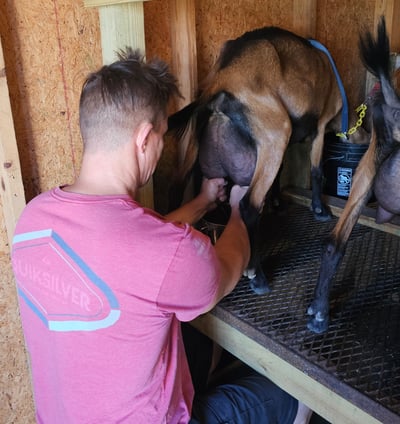We will be milk testing soon!
This is our first year DHIR milk testing, so it's been an experience figuring out how to go about it and getting started. We are on the right track to start testing this month once I get a scale and get it certified. On this page, I'll be posting a picture of the results as they come in.
We're doing this for a couple reasons. For one, we have 2 out of our 3 in milk right now that I am pretty sure can get milk stars for the amount they put out. Miss Daisy being number 1, putting out over a gallon a day and Gem number 2, putting out right around a gallon give or take depending on her mood.
And the other more important reason is we'll be getting an analysis of the milk from each goat each month. It includes, first and foremost, the somatic cell count. If high, it would indicate someone likely has mastitis. In which case we'd pull from selling until tested clear. Also included are butterfat, fatty acids, protein, casein, lactose, total solids, milk urea nitrogen, and freezing point depression. All of which should give us a good idea of the milk quality.
We do not use antibiotics unless absolutely necessary (and haven't had to yet.) If we do end up having to use them, the milk will be tested clear before being offered up for sale again.
We have switched to organic feeds for the milking girls. We have made a homemade mix of Field peas, Barley, Oats, Wheat bran, Flax, and a mineral salt through Azure market. It's a little more cost effective while still using quality ingredients. Plus, we have a little more control over what all they get and can tweak it as we go individually if needed. There's bound to be a mix of hard and easy keepers. Those ingredients give us a very nice well rounded amount of nutrients that pairs well with the Redmond selenium 90 mineral salt we selected to use. They have been on organic only feed for over a month, now.
We have not needed to worm since we've started. So, no concerns of wormers showing up in the milk. Everyone looks great and healthy. We keep the hay up in nets (which can be controversial, but the holes are small and there's no horns in this herd) and the feed buckets are over rump height. They already don't like eating things below their knees, so keeping their food up works very well to keep them from getting increased parasite loads from eating around their poo. And keeping proper minerals for them help keep their immune system kicking hard and keeping things in check. When we have the vet out for blood work this year, we do plan on having a couple fecals run out of curiosity.
We do drink our own milk, which is allowed. Though I'm going to put this disclaimer here as well that we're selling pet quality and it's not for human consumption. I find it very nice, though, not goaty at all, even after being in the fridge for over a week it still tastes great. It tastes similar to cow milk from the store, but better, a little sweeter. If it sits undisturbed for a few days, the cream does slowly separate and if not shaken first, I get a nice bit of cream on my cereal. Which is sweet and delicious.
We milk by hand into a clean, sterilized stainless steel bucket. Teats are cleaned with a chlorhexidine solution made just for this. The goats' hair is kept trimmed on their udder and belly so we don't get hair falling into the bucket as we milk. It also help keep dirt and bedding from sticking, making it easy to brush them off. After milking, their teats are sprayed again. The milk is brought in and run through a clean, sanitized stainless steel pour through coffee filter into clean, sanitized glass jars and put right in the fridge to cool. Buckets and filter are washed with hot water and detergent specific to cleaning milking equipment and then sanitized. Some people put the milk on ice, or in the freezer first to cool it faster, we may be switching to doing it this way very soon or trying a convertible fridge/freezer that may be more efficient in cooling quickly.


